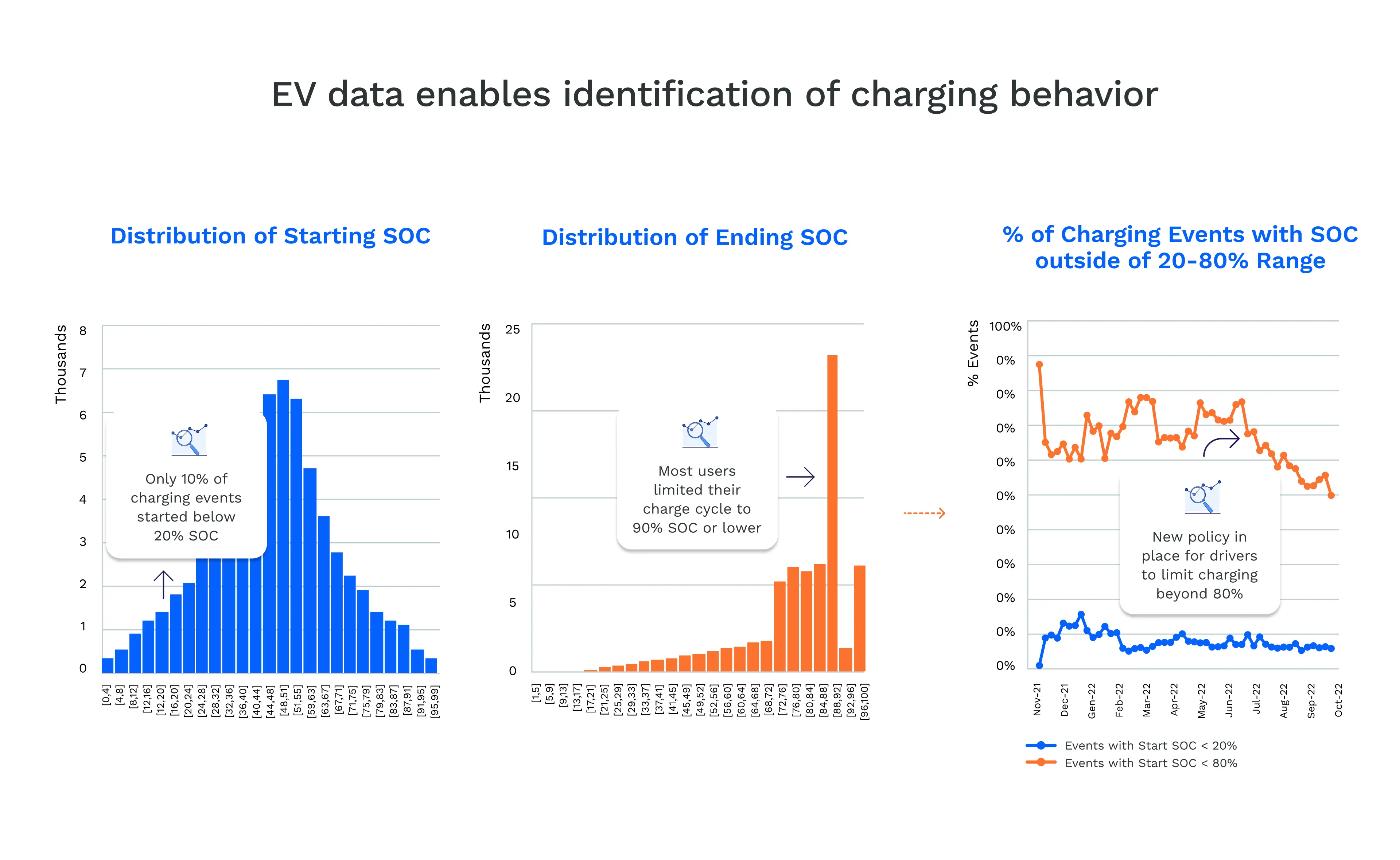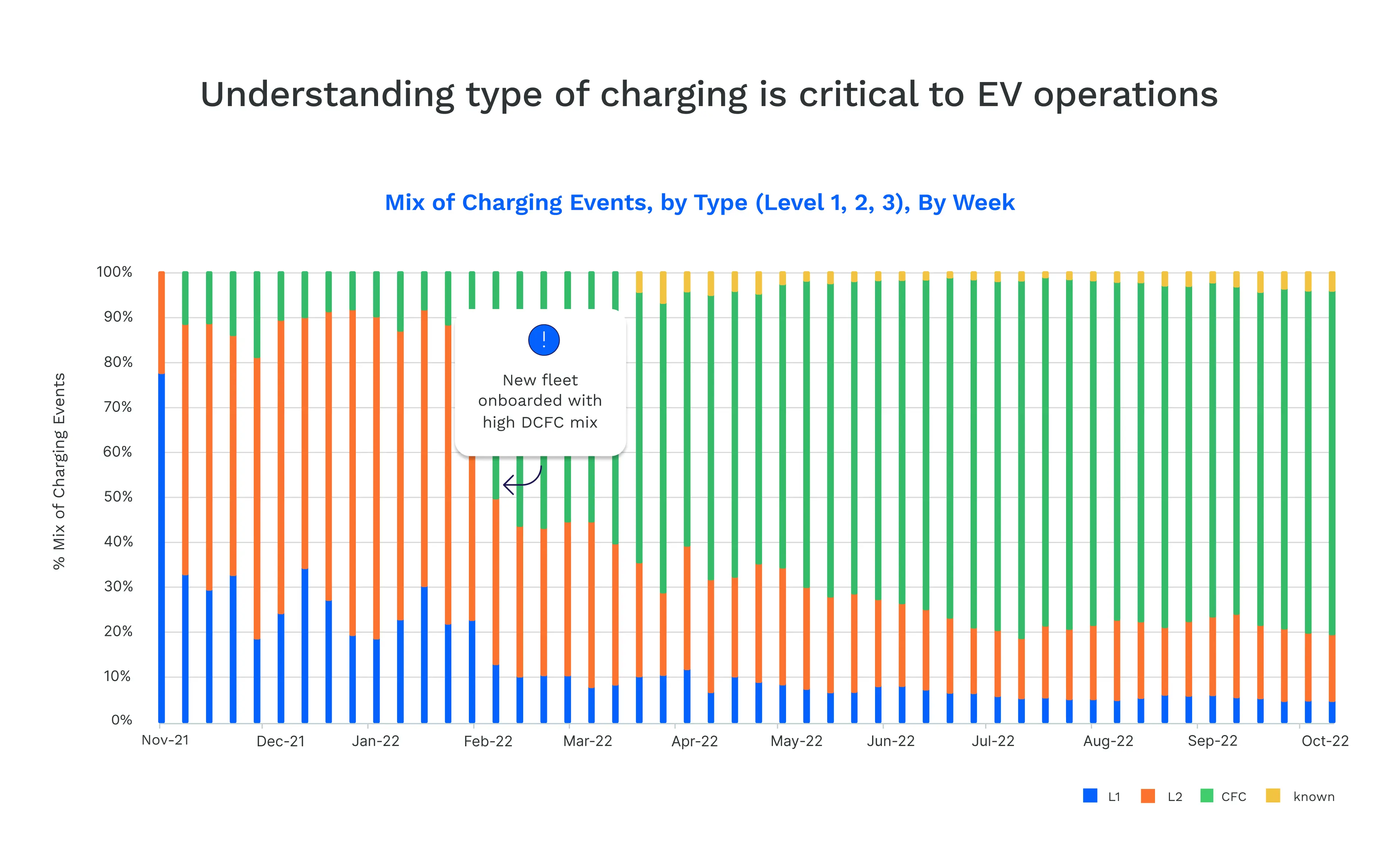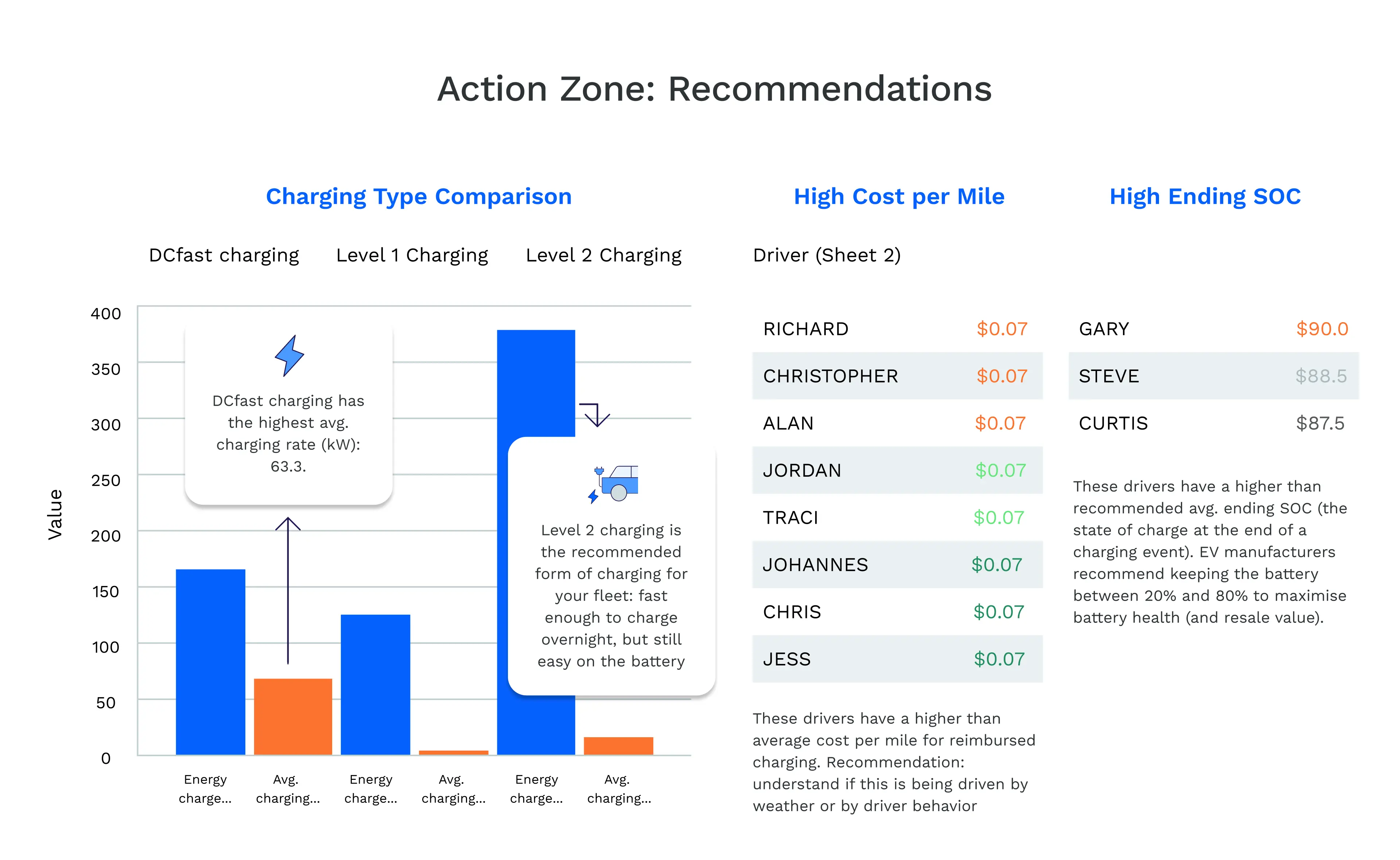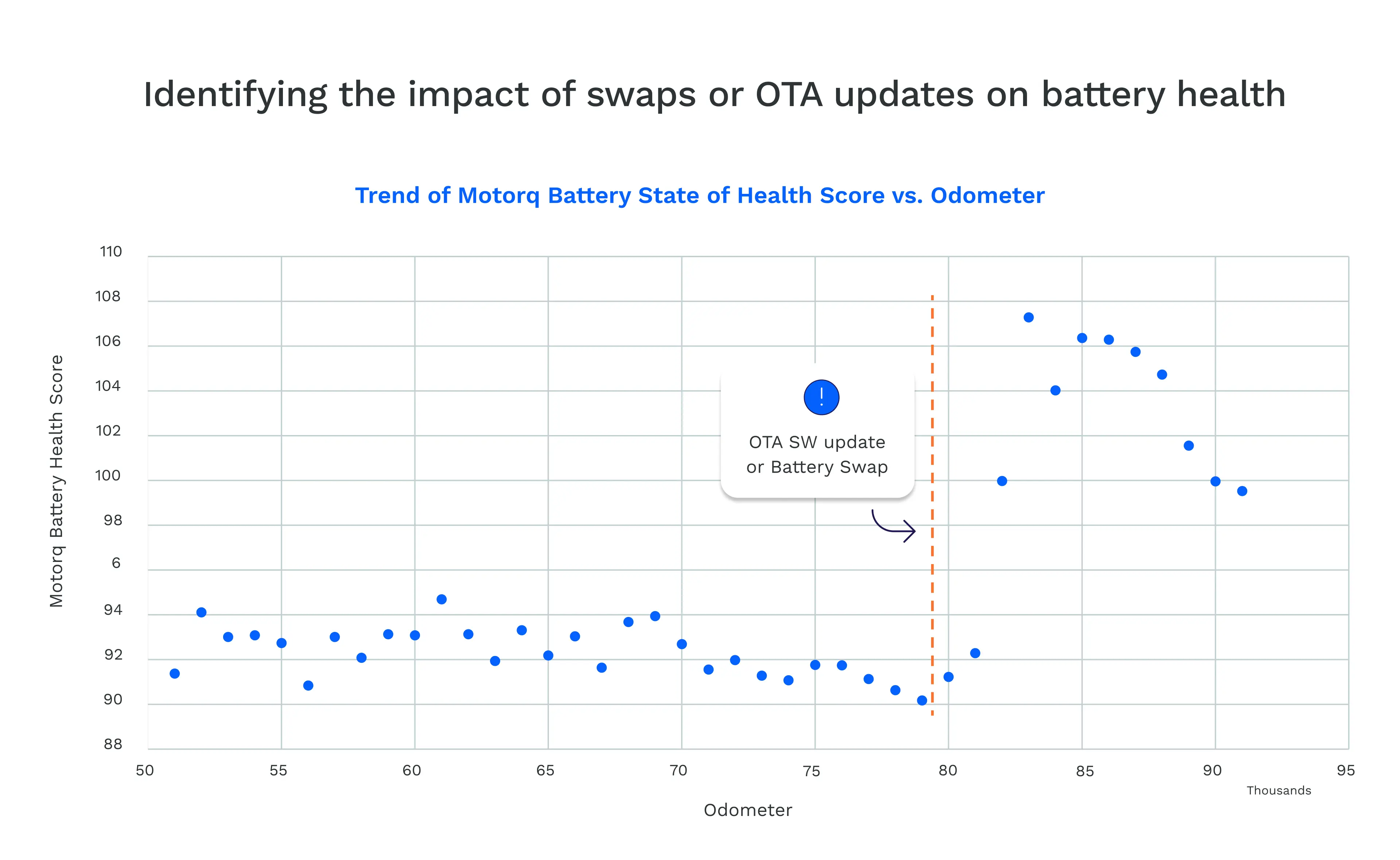EV Insights Every Fleet Manager Should Know

The ROI on electric vehicles is emerging. And so is industry anxiety around how to unlock EV value.
Hertz’s executive team recently touted a 50-60% savings on their Tesla fleet vs. their internal combustion engine vehicles. This savings showcases just how much of an operational win EVs are for fleet managers due to simpler maintenance. So, why aren’t all consumers and businesses electric?
Alongside supply chain challenges and charging infrastructure, the barrier to entry we hear about most often from our customers is implementing data to track and analyze EV success.
The amazing characteristic that EVs have is: The data is built in. Here are the most important benchmarks that EV connected data offers and how to implement them in your business to make high-impact decisions:
- How to Identify and Monitor EV Charging Behavior
- Using Connected Analytics to Ensure SOC Compliance
- The Value of VIN-Level SOC Insights
- Maximizing Battery Health by Monitoring the Types of Charge: Level 1, Level 2, DC Fast-Charging
- When Are Changes in Battery Health Worth Addressing?
What’s Your Average SOC? How to Identify and Monitor EV Charging Behavior
Most of us are familiar with charging best practices: Don’t let your charge fall below 10-20% and don’t charge past 80-90%. But how do you enforce that rule? Here's how to tackle the nuances that come with SOC guidelines, varying manufacturers, and diverse routes.

Be Confident Your EV Fleet is SOC Compliant
A full view of charging distribution patterns across your entire fleet is the first step. This data makes it easy to know whether your fleet meets company-wide guidelines and which vehicles are the outliers. Most companies will have a policy that requires drivers to minimize how often they let their charge fall below 10-20% and charge above 80-90%.
The biggest question is: how are your drivers doing?
With distribution reports accessible straight from your EVs, fleet managers can be confident that the majority of their fleet is following these guidelines. If for one month 10% of your fleet is charging outside of the recommended percentages and the next month 18% of your fleet is accountable for this same pattern, you’ll be able to pinpoint an 8% violation of your compliance policy and most likely even assign this overage to changes in your fleet (such as a new policy) while you work on reducing that number.
Here’s an example of a vehicle that is charging to 100% regularly:

The Value of Viewing SOC Data at the VIN-Level
In Motorq’s standard EV reports, you can view state of charge at the VIN level. This is where the fun begins when it comes to optimizing your fleet using real-time insights.
Are the drivers who are charging outside of your compliance standards:
- Assigned to longer trips, signifying they need a route change?
- Located in areas where ambient temperatures are dropping or rising substantially, decreasing their EV vehicle's range?
- Simply not following the recommendations and need coaching?
You’ll likely notice there are a few repeat offenders when you take a look at the VIN-level data. The same vehicle or set of vehicles may, for example, be consistently charging right at 20% each week. This makes it easy to pinpoint and resolve this pattern with those drivers and nudge them to charge more compliantly.

Know The Type of Charge So You Can Protect Your Assets
Battery health is a question mark for everyone in the industry. The traditional thinking is that having a blend of charge types across your fleet is crucial for asset management and risk monitoring.
You’ve probably noticed some studies such as this one conducted by the Idaho National Laboratory arguing that fast-charging doesn’t degrade the battery as much as we think. Take a closer look at this data and you’ll see the vehicles tested saw a 23-27% drop in battery range just within the first 50,000 miles. At mile 200,000, this drop in range could be significant when spread across an entire fleet that’s expected to maintain longevity and prevent premature and costly battery replacements. Not to mention, the wear and tear on battery is dependent on the manufacturer and battery type whereas studies like these often test one vehicle.
Maintaining a safe blend of charging types across your fleet is still the easiest way to protect your EV assets against classic battery wear and tear. And reliable access to charging data is still your best bet to get there. You’ll want a blend of level 1, 2, and 3 charging — and you’ll want to be empowered to notice changes in charging types by month, as well as attribute those changes to root causes such as a new fleet being onboarded.

As we get closer to 2030, charging stations will multiply. The International Council on Clean Transportation (ICCC) predicts that while home charging made up close to 80% of EV electricity consumption in 2020, it could fall to 59% by 2030, at least at the consumer level. With drivers everywhere gaining more access to roadside charging as more EVs roll off the supply chain, you’ll want to know how many drivers are relying too heavily on charging stations, past the recommended amount.
Since where your drivers are charging also impacts the cost of electric fuel, many companies gravitate toward level 1 home charging. Home charging costs about 50% of what public charging does, a savings that quickly becomes crucial as your EV fleet scales.
No matter the makeup of your fleet, charging type is a key benchmark for anyone looking for operational success within their EVs.
Detect Real-Time Changes in EV Battery Health
Lastly, you’ll want to look at your battery health fleet-wide and at the VIN-level to see if there’s a correlation between a drop in health and another change within your fleet.
In the chart below, the use case here is there was an over-the-air (OTA) update or battery swap that caused a massive spike in battery health score. The ability to predict these increases and decreases and even pinpoint the reason so you know whether there is a cause for action is crucial. Perhaps there’s a recall, and that impacted your battery health score. Or maybe there’s a behavioral issue within your fleet that you do have control over and must reactively resolve.

The Data is Built-In
What’s unique about EVs is the data comes standard. No dongle. Just connectivity. Whereas older ICE vehicles often surface incomplete or bad data via a 3rd-party device, EVs are data-native. The challenge for fleets is adopting new best practices and operational requirements to maximize EV ROI, all while minimizing business risk. That’s why vehicle data is a real driver of fleet electrification. It empowers EV fleets to achieve success.
It all starts with access to the next generation of telematics information: connected data.